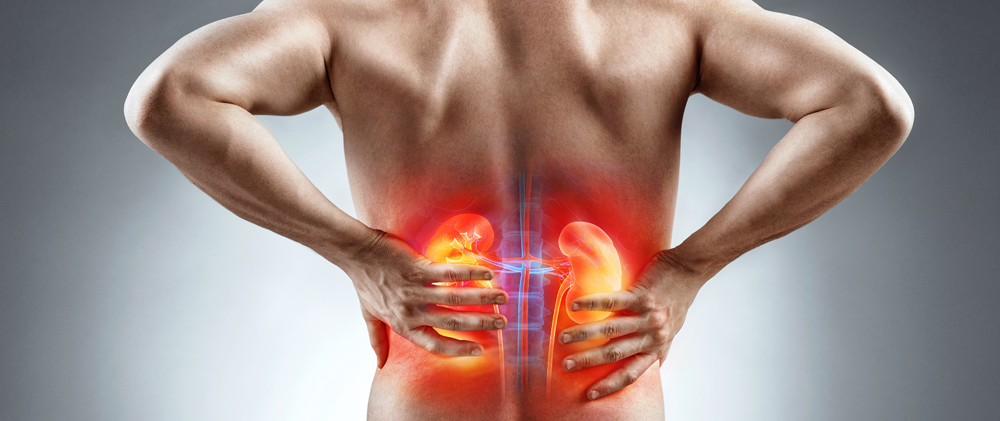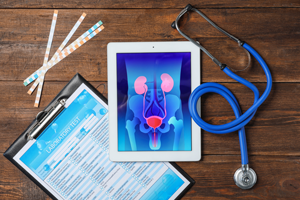



According to recent genetic studies, mutations in the SLC3A1 and SLC7A9 genes are thought to be the main cause of an increased risk of stones. Both genes code for subunits of important transport proteins in the renal tubules and the small intestine. If a gene defect is present, there is a disturbance of the transport in the sense of resorption disorders and, as a consequence, an increased excretion of the amino acids cysteine, ornithine, lysine and arginine.

Although all of the amino acids mentioned reach a high concentration in the urine, cysteine is considered the stone-forming substance. This is because cystine (cysteine-cysteine) is insoluble in acidic to normal urine pH range. This leads to cystine precipitation, the formation of cystine crystals and consequently to stone formation.
In the course of life, more than 50% of patients suffer from cystine-related stone condition, whereby the manifestation of the disease can basically occur at any age. In more than 80% of cases, the disease becomes apparent in the first two decades of life. Early onset of stones seems to be more likely in male patients than in female patients. In addition, male patients are more frequently affected than female individuals.
The increased excretion of cystine alone does not usually cause any symptoms. These first appear through the formation of cystine crystals and later through cystine stones, which in turn can lead to serious complications.
These include:
However, especially in younger children, the symptoms are more unspecific, which is why it is often difficult to find the right diagnosis.
Symptoms that occur in children
If Cystinuria is suspected, the following examinations can be carried out to clarify the findings:

Patients who have already been treated with medication should visit their doctor at regular intervals for follow-up examinations to measure the success of the therapy.

Since Cystinuria is a genetically determined stone formation, a cure for the causal cause - the genetic defect - is not possible at this time. The aim of treatment is to prevent further complications, whereby the general prospect of therapeutic success depends on the following factors:
The pillars of conservative therapy serve the goal of reducing the increased cystine concentration 24 hours a day - day and night - to a normal range. This reduces the likelihood of developing a kidney stone and can prevent rare but serious complications.
Alkalization therapy
Cystine-binding drugs
The use of alkalizing substances is recommended for all Cystinuria patients. They raise the urine pH significantly above 7.5 and thus lead to better solubility of cystine.
If cystine levels are present in very high concentrations, so-called chelating drugs, which break the bonds in cystine and form a well soluble cystine drug complex, are used. These are recommended especially for very high cystine levels of over 3mmol / day.
If the above treatment options are not effective and a stone forms or an emergency situation occurs, e.g. a complete blockage of the urinary tract and thus a life-threatening urine backflow into the kidney, various invasive and surgical treatment options can be used, depending on the size and location of the stones. Since Cystinuria predominantly takes a recurrent-chronic course, adequate adjustment of the cystine concentration is essential for the prevention of further events.
The information on this website is for general educational purposes only and is not intended to make a diagnosis or to recommend a treatment. Please consult a doctor for any medical questions regarding this condition.
Katz G, Pras E, Landau EH, Shapiro A, Pode D. Cystinuria and urolithiasis. Harefuah. 1995; 129(1-2): 12-5, 79. Hebrew. PMID: 7557700.
Knoll T, Zöllner A, Wendt-Nordahl G, Michel MS, Alken P. Cystinuria in childhood and adolescence: Recommendations for diagnosis, treatment, and follow-up. Pediatr Nephrol 2005; 20(1): 19–24. https://doi.org/10.1007/s00467-004-1663-1
Moussa M, Papatsoris AG, Abou Chakra M, Moussa Y. Update on cystine stones: current and future concepts in treatment. Intractable Rare Dis Res. 2020; 9(2): 71-78. doi: 10.5582/irdr.2020.03006. PMID: 32494553; PMCID: PMC7263987.
Saravakos P, Kokkinou V, Giannatos E. Cystinuria: current diagnosis and management. Urology. 2014; 83(4): 693-9. doi: 10.1016/j.urology.2013.10.013. Epub 2013 Nov 16. PMID: 24246330.
Sternberg K, Greenfield SP, Williot P, Wan J. Pediatric stone disease: an evolving experience. J Urol. 2005; 174(4 Pt 2): 1711-4; discussion 1714. doi: 10.1097/01.ju.0000179537.36472.59. PMID: 16148688.
Strologo, LD et al. Comparison between SLC3A1 and SLC7A9 cystinuria patients and carriers: A need for a new classification. Journal of the American Society of Nephrology 2002; 13(10): 2547-2553. https://doi.org/10.1097/01.ASN.0000029586.17680.E5
Weigert, A., Beck, B.B., & Hoppe, B. Genetische Nierensteinerkrankungen. Medizinische Genetik 2018: 30, 438-447. https://link.springer.com/article/10.1007/s11825-018-0227-x (Abruf 30.03.2021)
Worcester, E.M., Coe, F.L., Evan, A.P. and Parks, J.H. Reduced renal function and benefits of treatment in cystinuria vs other forms of nephrolithiasis. BJU International. 2006: 97: 1285-1290. https://doi.org/10.1111/j.1464-410X.2006.06169.x